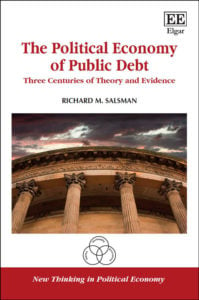The Political Economy of Public Debt: Three Centuries of Theory and Evidence, by Richard M. Salsman. Northampton, MA: Edward Elgar, 2017. 322 pp. $126 (hardcover).
Dr. Richard M. Salsman’s book is an intellectual laser beam that offers clarity and precision in an important but neglected area of political and economic thought: public debt theory. The book’s title indicates the ambitious scope of the project, and the result matches the ambition. The book is engagingly written and structured in a concise, intuitive manner that traces the development of public debt theory from its earliest Classical era to the more recent Keynesian and Public Choice schools of thought.1
One thing in particular that makes Salsman’s discussion accessible and enjoyable to read is that he quotes writers at length, which enables readers to form their own conclusions about the ideas under discussion, rather than relying solely on Salsman’s assessments. This not only provides greater clarity; it also unearths some surprises. For example, I was surprised at the antipathy that many pro-free market classical economists have had toward any level of public debt. Adam Smith held that public debt “enfeebles” states and tended to “ruin” them, and he only reluctantly admitted that in the “exigency [of war] government can have no other recourse but in borrowing” (54).2
Anti-free market economist John Maynard Keynes is well-known for his antipathy toward creditors. He called bondholders “rentiers” and called for their “euthanasia” by having government drive interest rates down so low—as close to zero as possible—that these “rentiers” would be destroyed (9).3
 This policy may sound familiar. Central banks, including America’s Federal Reserve, have deliberately kept short-term interest rates close to zero, a policy termed “financial repression.” Salsman explains why:
This policy may sound familiar. Central banks, including America’s Federal Reserve, have deliberately kept short-term interest rates close to zero, a policy termed “financial repression.” Salsman explains why:
Zero-interest-rate policies (ZIRPs) [have been] in place in Japan since the mid-1990s and since 2008 in the United States, Britain, and the eurozone. . . . Artificially low public bond interest rates disguise the full cost of public borrowing just as public borrowing itself disguises the full cost of public spending; each reflect a policy of making a costly welfare state seem less costly to a democratic electorate than it really is. (253)
Salsman classifies public debt theorists into three categories that clarify their essential differences: pessimists, optimists, and realists. As one might expect, Salsman is a realist. As he explains, “Public leverage, for the realist, is neither inevitably disastrous nor metaphysically infinite”; whereas “pessimists seem continually dumbstruck that things aren’t deteriorating as much as they feared, while optimists seem perpetually surprised that things aren’t improving as much as they hoped” (260).
Both realists and pessimists tend to be advocates of limited government; optimists typically are Keynesians, who believe that expansive government “stimulus” spending—and resulting budget deficits—benefit the economy. But in contrast to debt pessimists, who regard public debt as inherently problematic, debt realists see a constructive role for public debt. For instance, realists regard debt as essential for funding short-term government projects necessitated by emergencies—such as foreign aggression, which requires military defense. And, Salsman argues, when government is limited to its essential functions of “national defense, police protection, courts of justice, and basic infrastructure,” the resulting free economy is productive enough to pay down the debt rapidly after the emergency has passed (260).
Salsman carefully distinguishes between public credit, which is the ability to take on debt, and public debt. “A sovereign may have too much debt relative to its credit, but its credit alone can never be excessive” (5).
The hallmark of the debt realist is his appreciation of context. The realist holds that one cannot evaluate whether a public debt is too large if one does not also evaluate the purpose of the debt (e.g., military defense) and the carrying capacity of the economy to pay down the debt.
The prototypical debt realist—admiringly discussed at length by Salsman—is Alexander Hamilton, America’s founding secretary of the treasury under President George Washington. Hamilton was a realist because he saw the public debt incurred to fund the Revolutionary War as a legitimate debt that should be honored and could be honored—provided the United States developed robust financial institutions. And Hamilton made that happen. He devised new institutions in banking, tax collection, and sound money that made it feasible for the young country to pay off its debt.
Opposing Hamilton, Salsman explains, was the debt pessimist Thomas Jefferson. Jefferson denounced the “moneyed interests” and opposed Hamilton’s plan to fund the Revolutionary War debts. He was also an admirer of Count Destutt de Tracy, a French political economist who held that all public debt is “evil” and advocated debt repudiation. Describing himself as an “enemy” of public debt, Jefferson only reluctantly recognized its value in paying for national defense (71). Summarizing the debate between the two men, Salsman writes:
Alexander Hamilton and Thomas Jefferson differed pointedly over whether government should borrow at all, whether it should fully pay its debts . . . whether the currency in which debts were to be repaid should be gold backed and of uniform consistency nationally, whether public obligations should extend to future generations or instead be cancelled, and whether private banking was legitimate. On all such questions Hamilton answered in the affirmative, Jefferson in the negative. (32)
Salsman shows that, despite Jefferson’s contribution to the American Revolution, his understanding of banking and the role of the national debt was deficient.
The final section of the book reviews the current outlook for the United States (and the developed world) with regard to public debt. Salsman’s assessment is that the prospects of paying down or properly managing the public debt are bleak. The U.S. national debt now stands at $18.96 trillion and is rapidly growing. But as a percentage of GDP (104 percent currently), it is still far lower than was Great Britain’s debt at two points in its history. Britain’s debt stood at 261 percent of GDP in 1819, at the conclusion of the Napoleonic War, and at 230 percent at the end of World War II (78, 17).4 The problem, Salsman argues, is not the size of the debt per se but its continuing, rapid accumulation in peacetime for consumption purposes. “Until 1930 the peacetime ‘norm’ had been to restore pre-war budget balance and if possible generate budget surpluses to permit debt reduction; since 1930, with chronic deficit spending in wartime and peacetime alike, the norm has been perpetual public debt accumulation” (7–8).
A contributing factor in today’s predicament, Salsman notes, is the abandonment of the gold standard. Fiat money printing enables governments to partially default on their national debts via inflation. Since the ending of the last vestiges of the gold standard in the early 1970s, annual inflation has averaged 4 percent.5 Inflation reduces the real value of debt and is a hidden means of partially repudiating debt.
Ultimately, Salsman’s analysis turns on a factor that is rarely mentioned by economists or political economists: a nation’s moral and political ideals. Of profligate spending, Salsman writes, “its root cause is arguably moral-ideological-political” (8). “It’s well known that today’s electorally sensitive politician resists spending cuts or tax hikes because (most) voters simply won’t have it; yet they both want the welfare state, so they’ll have deficit spending, thus highly leveraged sovereigns enacting policies that risk causing decades of grueling economic stagnation” (261).
During the 19th century, Salsman observes, the culture in many Western countries was individualistic, and the role of government was strictly limited. As a result, extraordinary public debts incurred in wars of self-defense were paid down promptly. Despite often having large debt-to-economy ratios (sometimes even larger than today’s), Western countries tended to have good credit. They had the capacity to pay down their debt because their economies were largely free and substantially unencumbered by government interference. And they were willing to pay down their debt because political leaders considered it a duty of a responsible citizenry. In contrast, today: “democracy and (to a lesser extent) autocracy, although by now the world’s predominant political systems, are also the most fiscally reckless, because [they are] the least constitutionally constrained” (260).
Salsman makes the case that two types of governments—authoritarian states and democracies—are most profligate in government spending and the accrual of excessive public debts. Authoritarian states, such as the monarchies of old and the dictatorships of today, tend to incur large debts to satisfy the personal desires of the rulers, typically for war. Democracies, on the other hand, also tend to be profligate, to satisfy voters’ demands for government largesse. Salsman quotes Alexis de Tocqueville who, observing Americans in his 1835 book Democracy in America, says that when “the people is invested with the supreme authority, the perpetual sense of their own miseries impels the rulers of society to seek for perpetual ameliorations” (2).
Today, Americans’ “sense of their own miseries impels the rulers of society to seek for perpetual ameliorations” on a vast scale. The democratic governments in the United States and around the world seek to alleviate nearly every imaginable “misery” of their citizens. At the behest of voters, democratically elected governments pay for medical care, housing, education, food, entertainment, parks, pools, and sundry other goods and services for voters who are ever hungry for more. The result is nearly perpetual budget deficits that have piled up to a national debt of $18.96 trillion (23).6
There is little to criticize in Salsman’s engaging book. One topic not discussed by Salsman is the role of public debt in a laissez-faire society, where all government financing is through voluntary means. Can a society with no coercive taxation—a society in which all government financing is through voluntary means—have sufficiently good credit to borrow enough money to deal effectively with emergencies such as foreign aggression requiring massive self-defense? Granted, we are far from achieving a laissez-faire economy. But this question will have to be addressed by debt realists of the future.
Salsman’s book is aimed at a scholarly audience, and its review of public debt theory over the past three centuries is comprehensive (as the thirty-eight pages of references at the end of the book attest). In this capacity, it is a tremendous resource for anyone interested in scholarly questions relating to the sustainability and political economy of public debt, or the history of political economic thought. But the book is accessible to anyone with a midlevel understanding of economics. And any reader who wants to understand the history of public debt and our debt-laden future will find himself indebted to Salsman for this book.
You might also like
Endnotes
1. Some representative economists from each era: Classical (1776 onward: Adam Smith, David Ricardo, and Jean-Baptiste Say), Keynesian (1930s onward: John Maynard Keynes, Alvin Hansen, and Abba Lerner), and Public Choice (1950s onward: James Buchanan and Richard Wagner).
2. Smith’s wariness of public debt made him a debt pessimist, explained below.
3. Keynes detested public bondholders (“rentiers”), but he nevertheless advocated an expansive role for public borrowing. He and his followers were debt optimists, explained below.
4. GDP stands for gross domestic product, a measure of the economy’s total output. Great Britain successfully paid down the debt on both occasions. Although its public debt is growing again, today Great Britain’s public debt to GDP ratio stands at about 50 percent.
5. Calculated from the consumer price index, January 1971–June 2016. Cumulatively, the reduction in real value since January 1971 is 84 percent.
6. There was a brief and rare modern exception from 1998 to 2001, when the U.S. government ran surpluses and politicians even considered paying down the national debt. It didn’t last. Large budget deficits due to the War on Terror after 2001, and especially due to expenditures related to the housing finance crisis after 2008, caused the national debt to nearly double from 57 percent of GDP in 2000 to 104 percent of GDP in 2016.


![[TEST] The Objective Standard](https://test.theobjectivestandard.com/wp-content/uploads/2017/10/logo.png)













